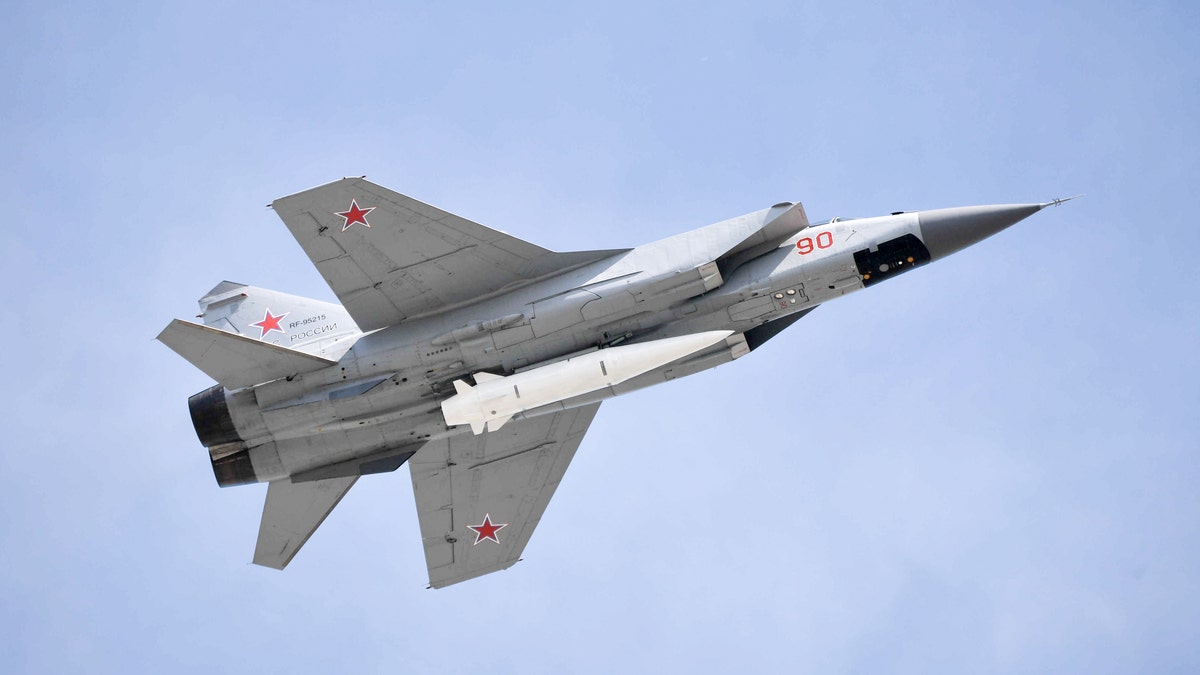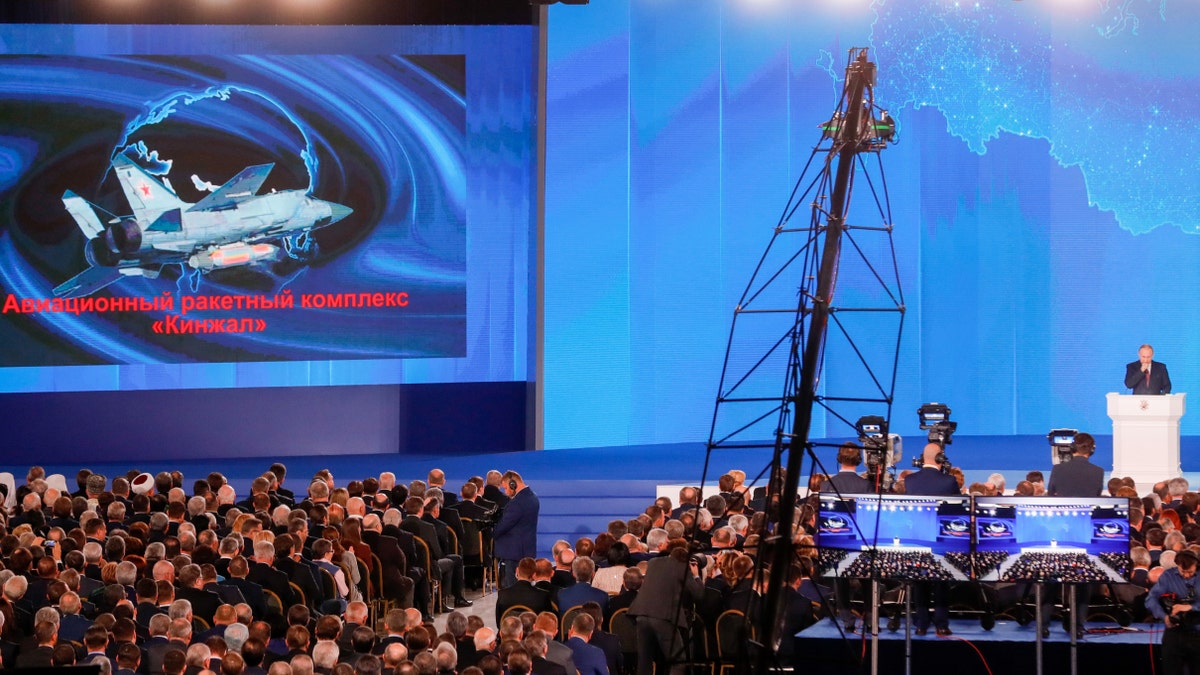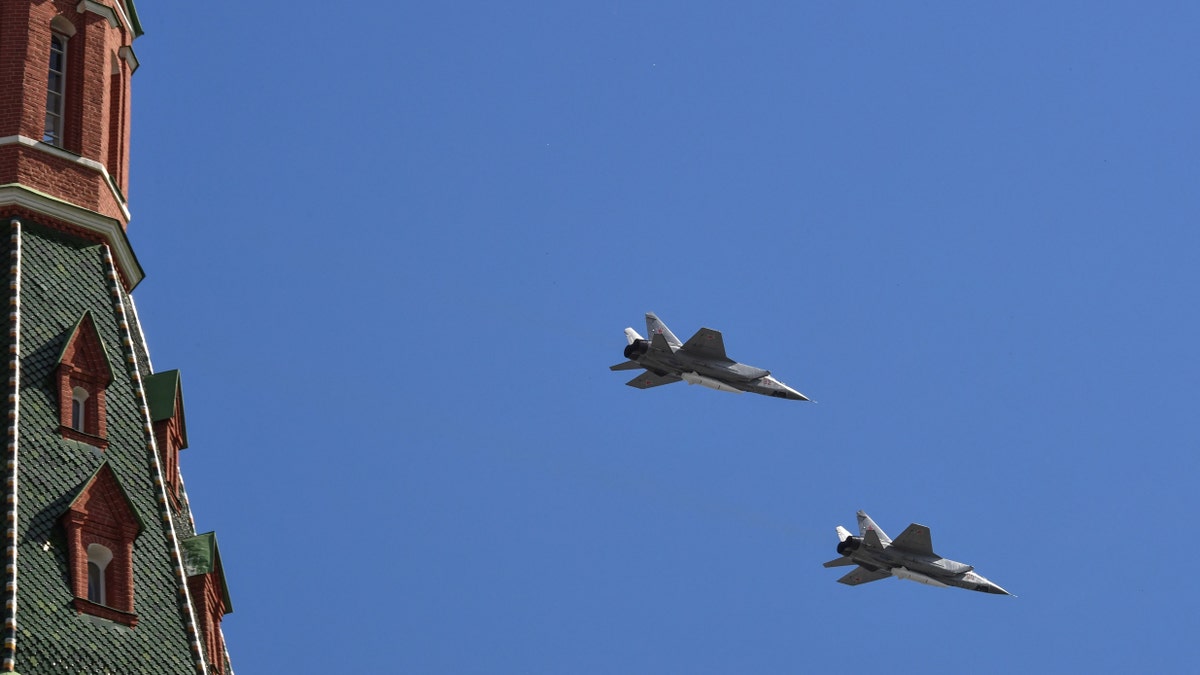
Mikoyan MiG-31K fighter jet with Kinzhal hypersonic missiles flies over Moscow's Red Square marking the 73rd anniversary of the victory over Nazi Germany in World War II. (Alexei NikolskyTASS via Getty Images)
The U.S. lacks the defenses needed to protect against a new breed of highly sophisticated hypersonic weapons from China and Russia, according to a Government Accountability Office (GAO) report.
“China and Russia are pursuing hypersonic weapons because their speed, altitude and maneuverability may defeat most missile defense systems, and they may be used to improve long-range conventional and nuclear strike capabilities,” the report said. “There are no existing countermeasures.”
Earlier this year, the Russian military said it ran a successful test of a nuclear-capable hypersonic missile capable of sneaking through enemy defenses.
US AIR FORCE: WE'RE IN ‘DANGER’ OF FALLING BEHIND CHINA AND RUSSIA BY 2025
A video posted by the Defense Ministry Sunday showed a MiG-31 fighter jet launching a Kinzhal (Dagger) missile during a training flight. The ministry said the missile, which carried a conventional warhead, hit a practice target at a firing range in southern Russia.

The video screen shows the Kinzhal missile system as Russia's President Vladimir Putin delivers an annual address to the Federal Assembly of the Russian Federation, at Moscow's Manezh Central Exhibition Hall. (Mikhail MetzelTASS via Getty Images)
Russian President Vladimir Putin said Kinzhal flies 10 times faster than the speed of sound, has a range of more than 1,250 miles and can carry a nuclear or a conventional warhead. The military said it's capable of hitting both land targets and navy ships.
The U.S. military has been busily ramping up its hypersonic weapons capabilities.
AIR FORCE SETS SIGHTS ON HIGH-TECH LASER WEAPONS
In April, the Pentagon announced a deal with Lockheed Martin to develop a “hypersonic conventional strike weapon” for the U.S. Air Force. The deal for the air-launched Hypersonic Conventional Strike Weapon (HCSW) is worth up to $928 million.

Russia's MiG-31 supersonic interceptor jets carrying hypersonic Kinzhal (Dagger) missiles fly over Red Square during the Victory Day military parade in Moscow on May 9, 2018. (YURI KADOBNOV/AFP/Getty Images)
Four months later, the Air Force awarded Lockheed Martin a contract of up to $480 million to design a second hypersonic prototype, the Air-Launched Rapid Response Weapon (ARRW).
“The ARRW and HCSW efforts are developing unique capabilities for the warfighter and each has different technical approaches,” explained the Air Force, in a statement. “The ARRW effort is ‘pushing the art-of-the-possible’ by leveraging the technical base established by the Air Force/DARPA partnership. The HCSW effort is using mature technologies that have not been integrated for an air-launched delivery system.”
In its response to the GAO, the Department of Defense described the report as "an accurate although sobering macro picture of how the US stands in the world against emerging threats."
Speaking to Russia's top military brass Tuesday President Vladimir Putin cited the air-launched Kinzhal hypersonic missile and the Avangard hypersonic glide vehicle, saying that they have significantly bolstered Russia's military capability.
"No one has hypersonic weapons yet, but we have it," he said.
Kinzhal has already been commissioned by the military, which put them in service with a squadron of MiG-31 fighter jets.
Russian Defense Minister Sergei Shoigu said Tuesday that the aircraft carrying missiles have flown 89 patrol missions over the Caspian and the Black Seas this year.
Contrary to Putin’s claims, U.S. officials say Russia has not deployed any of its hypersonic weapons which remain in test phase.
Fox News' Lucas Tomlinson and The Associated Press contributed to this article.
Follow James Rogers on Twitter @jamesjrogers
